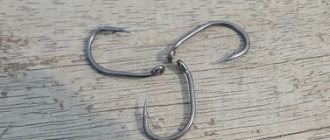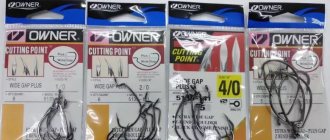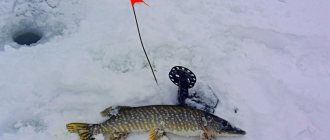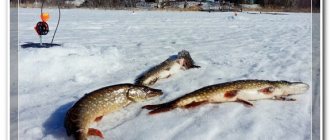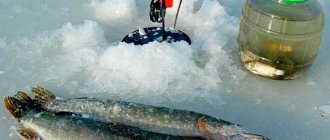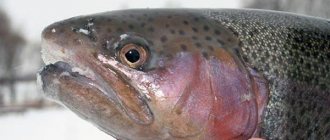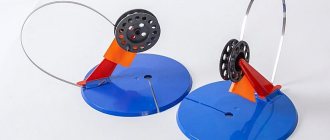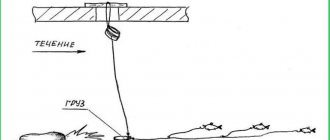Using girders for pike in winter brings a catch throughout the entire freeze-up period. There are fewer and fewer places on reservoirs where you can catch pike under almost every bush. Therefore, knowledge of the features of the bottom topography, impeccable equipment and the angler’s ability to seduce fish come first. The rigging is simple only at first glance. There are certain specifics, a number of features and nuances, the observance of which is necessary for successful fishing in this way.
Pike in winter
Winter fishing for pike with jigs is not a passive activity at all. The angler needs to find or catch live bait, then decide on the reservoir and location. You also need to find a toothy fish on a pond. Winter migrations of fry, changes in the oxygen regime in the water and weather can force the predator to leave its habitat. Read more about the winter behavior of the toothy robber in a separate article.
Winter baits for pike bring a bite even in the dead of winter, when it is difficult to catch a toothy fish with artificial bait. Live fish are traditionally considered the best bait for this predator. Winter girder fishing occurs according to a specific strategy for choosing a place and tactics for finding fish. The features of catching a toothy robber with flags, the process of installing winter girders and the nuances are discussed in this article:
Here we will analyze in detail the design of pike girders in winter, the design options for gear, and the features of equipment depending on various fishing conditions.
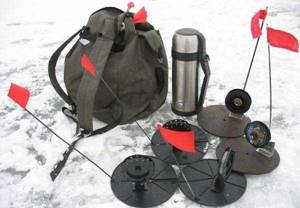
Design of the vent
Girders have many different designs, but they have the same principle, this is a fishing line with a leash and a hook wound on a reel or other reel, and a bite alarm. Let's look at the most common and popular designs of vents.
Broad based
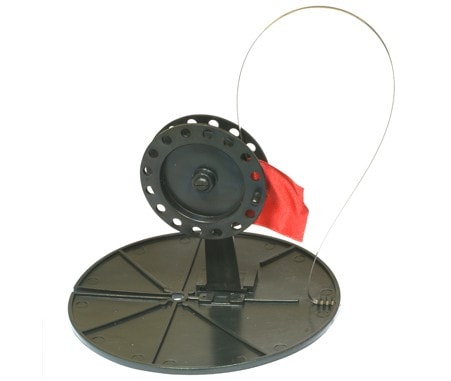
The reel is secured so that it can rotate freely. The signaling device is usually a bright flag on a flexible holder. The fishing line or cord is equipped with a strong leash and a weight whose weight corresponds to the size of the live bait. We attach live bait, lower it into the hole to the required depth, insert the fishing line into the radial slot, press the reel with a bent flag, and wait for a bite. When a pike bites, it reels out the fishing line, the reel begins to rotate and resets the flag, which straightens up, signaling a bite.
The advantage of this design is that the base completely covers the hole, thereby not alerting the pike and preventing the hole from freezing.
On legs
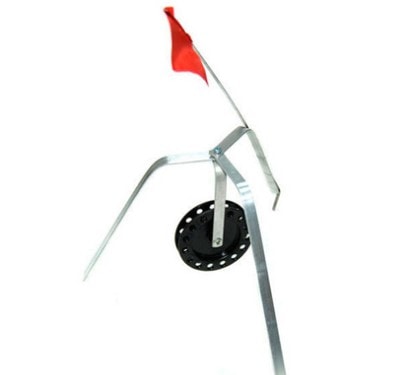
The winter girder on legs, or “Taganok”, differs from the previous design in that instead of a round base, the coil and alarm are mounted on a tripod. The reel is placed above the hole, the reel is pressed with a flexible flag. When triggered, the flag straightens, indicating a bite.
The advantages of this arrangement include the lightness of the gear and the fact that it is better visible and will not be swept away by snow , due to its greater height, and due to its good stability it will not be blown over by the wind.
The disadvantages include the flimsiness of the design, in which a good pike can drag it into the hole, and if you do not close the hole in the hole, it can freeze and damage the fishing line.
The reel should be attached to the vent without any backlash, the stroke should not be tight, but with a slight effort.
On the rail
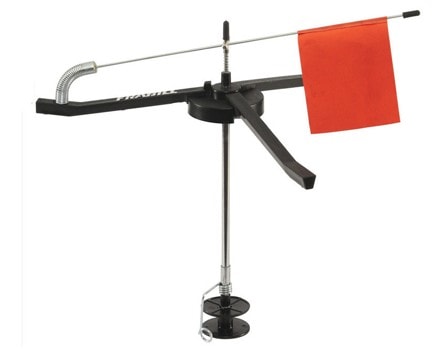
In its simplest form, it is a stand - a peg made of wood, metal or plastic, with a coil and an alarm, installed near the hole. The design is light, simple and effective, but it has a number of disadvantages. In the absence of snow, it is problematic to install it on bare ice. Added to this is the same instability and the possibility of the hole freezing.
The design flaws are taken into account in the following variation. Here, a rail is attached to a round base with a slot covering the hole, and a coil and a signaling device are already attached to it. With this arrangement, the hole is closed, the tackle will not be covered with snow, and the signaling device is far visible. The disadvantages include some cumbersome design.
Changelings
The changeling zherlitsa in its most common form is a stick, a plastic or metal-plastic tube about 40 cm long, this is the basis of the zherlitsa. In the middle, two knitting needles longer than the diameter of the hole are inserted into it perpendicularly, crosswise. On one side, the base is brightly colored - this is the signal part; on the other end, a split is made, the main fishing line is secured and wound.
The principle of operation of the girder is this: the live bait is lowered into the hole, the fishing line of the required length is unwound and clamped into the split. The lanyard is placed with emphasis on the knitting needles so that the part with the wound fishing line is directed upward above the hole. When bitten, the pike will lower it down and most likely drag it into the hole, tearing the line out of the split and starting to reel it out. At the same time, the signal part of the rod will stick up, signaling a bite.
The disadvantage of this girder is that the hole is constantly uncovered and can freeze.
Another version of the shifter's vent is a vent on a wide base in which the signaling device is made according to the principle of a rocker arm. In the cocked state, the signal arm is lowered down, and the clipped fishing line is raised up. When there is a bite, the yoke flips over and gives a signal.
Subglacial
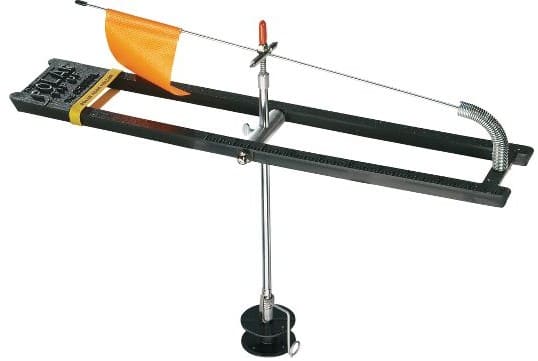
In winter, for pike, as under-ice baits, they usually use the same summer jigs without changing the equipment, but install them completely immersed in a hole under the ice, and securely attaching them to a rail placed across the hole.
Otherwise, the equipment of such a zherlitsa is no different from the summer one.
The advantage of such tackle is that it will not be damaged by freezing of the hole and can be left for a long period. The disadvantage is the lack of a signaling device.
Installation of girders (flags, stakes, supplies) for pike
What does a pike bait look like in winter? There are many options for the design of the gear, but the equipment is the same. The design of a winter pike trap should provide a number of functions:
- Hold the equipment of the set length in the hole so that when a pike bites, the line is easily released and does not prevent the predator from unwinding it from the reel. At the same time, when moving in the water, live bait should not be able to pull out the fishing line and unwind it.
- Bite alarm for fisherman.
- Stable position of all equipment above the hole on ice in various weather conditions.
- Overall ease of use, deployment and transport.
There are many varieties of winter fishing poles for pike. Some models can be bought in the store. In their likeness, many anglers make their own pike flags or improve store-bought products. The tackle for pike in winter is essentially a reel with fishing line with the ability to secure the equipment in the working position. At the same time, when a predator bites, it easily pulls out the fixed equipment and moves to the side when it grabs, but live bait is not able to do this. The alarm system is made of spring or pendulum elements with a flag or other bright object visible from afar. When bitten, these elements are also released or raised, fixing the unwinding.

Types of girders for pike in winter:
- On a flat platform screen. The base of the tackle is a plane (made of plastic, metal, wood), which is installed on top of the hole, protecting it from freezing. The plane has a cut for passing fishing line and a mount with a reel and a flag on top. When installed, the flag on the metal spring bends and rests against the reel, preventing it from unwinding under the influence of the current, weight and movements of the live bait with the sinker. But the jerk of the predator is enough for the flag to rise, the reel to become free and the line to begin to reel in. This is probably the best and most popular design. Fishing stores sell plastic collapsible flags, and many ice fishermen make homemade variations of such flags. When purchasing, it is important to evaluate the quality of the plastic so that it does not break when thrown onto ice, especially at low ambient temperatures.
- On a crossbar (rail, tube, board). The second most popular design. It is a strip (board) about 30 cm long (wider than the diameter of any hole). A coil, a wire flag on a spring and two staples are attached to the crossbar. In the working position, the flag is inserted between the brackets. A loop of fishing line is wound through them from above. When the fish bites, the loop is pulled out, the flag is released and the line is reeled in freely. The main advantage of this gear is its ease of manufacture. Our grandfathers made such winter pike stakes with their own hands. It’s easy to make them yourself and quickly from scrap materials. The disadvantage of a relatively platform pier is the lack of a protective screen for the hole.
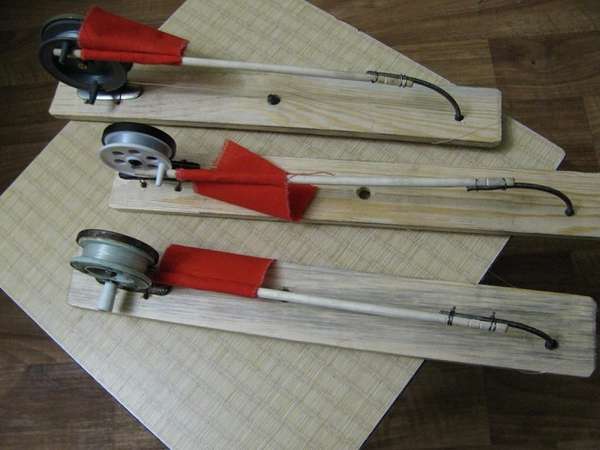
- Other options - on a peg, on a tripod (legs), upside-down crosses, magazine hatchets - have disadvantages that the above-described designs do not have. And the main disadvantage is an unstable position on the ice. It is impossible to stick a peg into the ice if there is no snow, and tripods or shifters are unstable in the wind.
Refinement and improvement of factory vents - video:
Above and below the ice
All of the above options are over-ice girders for active fishing. They imply constant monitoring of them and maintenance of the holes (clearing ice). In Siberia, the North and in rural areas, when the reservoir is often visited and the pike's anchorage areas are known, under-ice girders (postavushki, kolobashki) are more often used. It is advisable to use such gear for leaving it on a pond overnight and checking it in the morning. In the North, the practice is to permanently install shelters throughout the winter. To do this, two holes are drilled nearby. In one, the tackle is hung on the crossbar (all the equipment, including the reel with fishing line, is placed under the ice, in the water), the hole is left there and freezes. Maintenance, checking, fishing is carried out through the second hole.
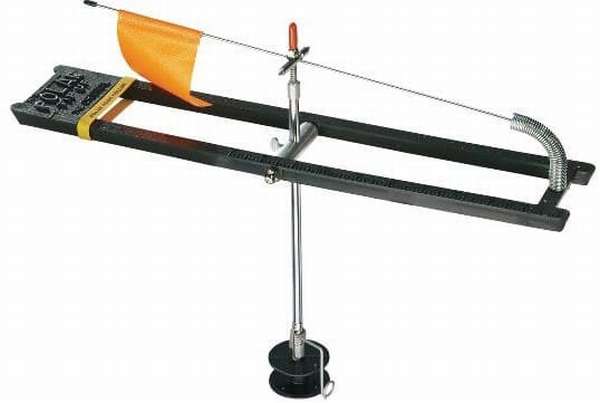
To get the equipment, it is picked up with a special wire poker (hook), and after reloading it is lowered into the water again. The reel itself with a slot (split) for fishing line was previously made of wood and was called a kolobashka (kolobakha). Now it is more advisable to use plastic reels, for example, from yogurt bottles filled with sand (so that they do not float). The line comes off well when unwinding. This principle is the progenitor of all spinning reels. Such a pike rig can last until the ice melts. If the hole is frozen, it’s okay, you can drill a new one nearby (or break the old one with an ice pick). In general, an ice pick is a very necessary tool for a girder. If a fisherman decides to get serious about fishing rods, then he will need to acquire such a tool.
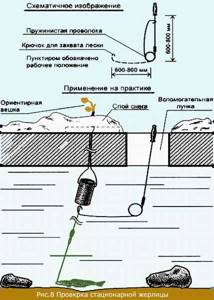
Finnish hook for pike

This type of hook has been known to anglers for a long time and is one of the most effective methods of successful fishing. It is made of steel spring wire 1 mm thick. It is easy to make, so many fishermen make it themselves.
A peculiarity of its design is that its fore-end is usually short and does not reach the gills of the fish, and there are 2 sharp barbels on it. Thanks to this structure, it easily falls into the throat and then into the stomach of the predator, after which the hook antennae stick into the tissue and become spaced, and sometimes the hook even comes out along with the entrails.
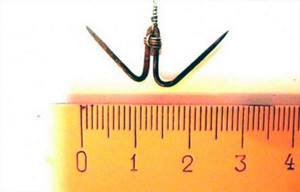
The predator almost never leaves such a bait, unless at the first stage of an attack or grip. Anglers are often advised to take spare leashes with Finnish hooks when hunting.
This is necessary in cases where a predator takes the hook in its throat, and it remains in its stomach for an indefinite time. In this case, to continue hunting, it is more convenient to unfasten the leash and put on a new one.
Live bait is attached to such a hook in a special way. To do this, a method is used to pass a metal hook leader under the gills of the bait. Then it is taken out from under the gill cover and attached to the clasp on the fishing line of the girdle. With this method, the bait swims in a natural position and attracts the attention of a predator.
How to equip pike girders in winter
Whatever the design of pike girders in winter, they all have one thing in common – the equipment. At first glance, the rigging for pike in winter is simple - line, sinker, leash and hook. Measure the working depth, plant the bait and lower it into the hole. But in fact, there are a number of features that must be followed, otherwise fishing may not be successful.
The equipment of a winter girder for pike is adjusted based on the fishing conditions, as well as depending on the winter period and the size of the expected trophy. Let's look at how to properly equip a girder for pike fishing in winter.
Coil tuning and modification
In order to properly adjust the girder for pike in winter, you need to check the tightening torque of the reel screw. The reel bobbin should turn easily, but not completely - otherwise a beard may form when the pike jerks sharply. Normal tightening of the coil is when, after acceleration by hand, it turns 5-7 turns and stops. Accordingly, when the tightening is strong, the screw needs to be loosened; if the coil is spinning for too long, on the contrary, tighten it. Most often, ordinary cheap plastic reels are installed on the vents.
Homemade crafts use plastic reels for fishing rods. This point needs to be checked on them too - it’s critical. In the dead of winter, a cautious pike can simply throw the bait if it feels excessive resistance. On good fishing rods for pike in the winter, reels from the store are of satisfactory quality. On cheap Chinese replicas, it is better to replace this element with a more reliable one. The factory flag is usually replaced with a larger and brighter one to make it more visible. When fishing at night, you can apply light-accumulating phosphorus varnish to it - this will make it even more noticeable.
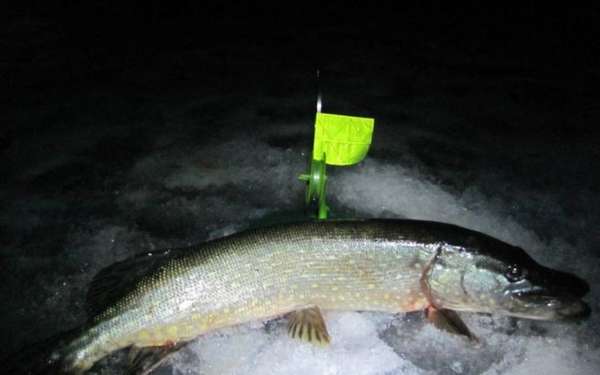
Standard equipment
How to properly assemble and equip a pike rig in winter? The basic equipment is the same - a fishing line, a sliding sinker on it, a leash through a swivel and a hook. The nuances lie in the characteristics of these accessories. To equip a winter fishing rod for a pike, 20-30 meters of fishing line is wound on a reel. A high-quality fishing line for fishing pike in winter is selected; the best option is winter fluorocarbon or fluorocarbon with low memory. The diameters of the reel reels are usually small, so a thick fishing line with memory will fall off from them in rings, which can alert a cautious predator. The thickness of the fishing line for fishing pike in winter varies depending on the angler’s experience in fishing and the expected size of the predator, usually it is about 3-04 mm. Naturally, the thinner the line, the more bites. Pike are often very cautious in winter.
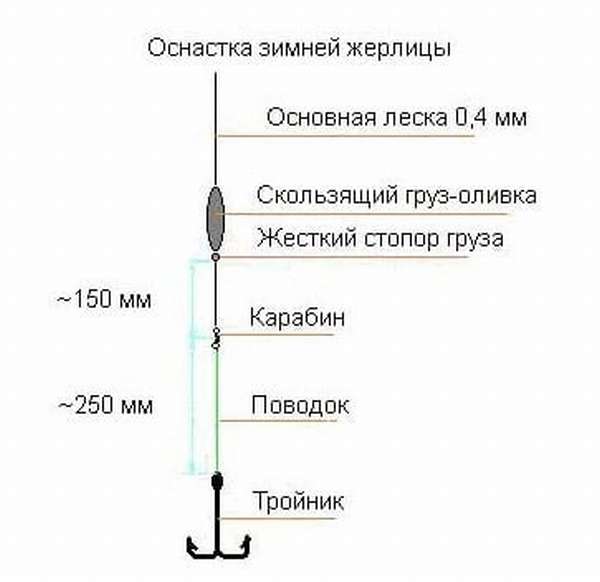
As a sinker, you can use any sliding options - it is more important to choose the right weight. Usually it is 10-15 grams. When fishing in deep water (or in the current, or when using large live bait), you will need a heavier load. The hole in the weight should not damage the fishing line. You can paint it in dark green or brown tones, but most often they don’t bother.
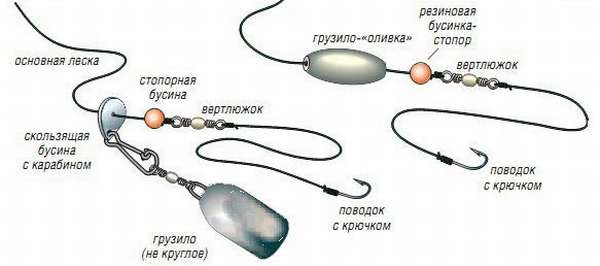
Some anglers consider equipping a winter lure for pike with a leash as a mandatory measure, while others complain that the use of this element of equipment greatly reduces the number of bites. Here you need to be guided by the following aspects.
- During the hot season (the first and last ice, active biting during the thaw) in winter, it is necessary to place leashes on the pike girders. At this time, the predator greedily swallows the bait, and there is a high probability of cutting the fishing line. You can use any store-bought leashes made of wire, tungsten, nichrome or Kevlar.
- In the dead of winter, the equipment of a girder for winter pike fishing with a leash is not necessary. It's even harmful. It is better to use high-quality fluorocarbon instead of a leash (you can double it). A special transparent leader material is also suitable.
- When choosing (or making) leashes, you should pay attention to high-quality accessories - fasteners and swivels. Cheap, low-quality parts can fail you when landing a trophy specimen.
- The rule for choosing a leash is one - for catching active fish, strength is more important, and for passive fish, the invisibility of the equipment is more important.

It is more convenient to have a set of leashes with you, and they are attached to the equipment using the loop-to-loop method (for quick change). During periods of active feeding, when the pike deeply swallows live bait, the angler does not waste time unhooking the hooks from the stomach or esophagus of the fish, but unfastens the leash and attaches a spare one instead. It is better to store a supply of leashes in a special leash holder or in a strip of polyurethane foam from a camping mat to prevent the hooks from rusting.
Different hooks are used for pike in winter; there is no consensus on this matter. When using small live bait and catching passive, cautious fish, it is better to use single hooks, in other cases - doubles or tees. It is necessary to monitor the sharpness of the sting and the presence of a beard. Naturally, low-quality hooks that bend or break easily are not suitable for pike fishing.
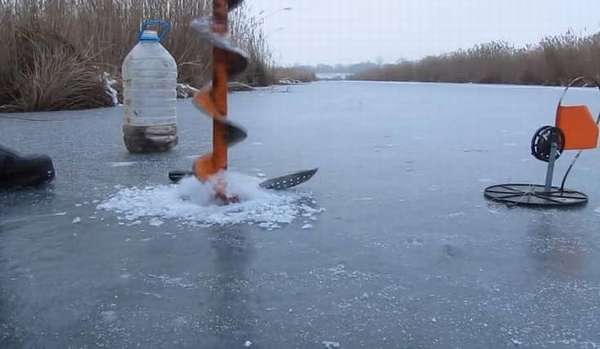
Fine equipment for deep winter
How to assemble a pike rig for winter fishing in the middle of nowhere? The predator at this time is sluggish and cautious; nothing should alert him. At such times, it is better to use thinner equipment. At this time and closer to spring, pike prefers small live bait. Therefore, the equipment of flags for catching pike in winter during this period is made thin, inconspicuous, but durable. The main line is fluorocarbon with a diameter of about 25 and thinner (for small pike). To attach live bait, a single hook is used; a leash is not used. If, nevertheless, the predator cuts the fishing line and does not take it to the metal, then the leash can be braided with a fluorocarbon braid. In this case, each twisted thread is separately tied to a hook.
An article about catching pike with girders in the middle of nowhere.
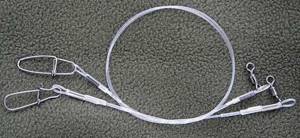
Homemade leader made from leader material or thick fluorocarbon:
For fishing in shallow water or currents
Sometimes the situation requires installing pike stands in winter close to the shore, where the layer of water under the ice does not exceed half a meter. In principle, in such conditions, conventional equipment is used, but for greater mobility of live bait, it is better to remove the sinkers. Accurate depth measurements are more important here. In the working position, the live bait must be located precisely in this layer of sub-ice water, otherwise the toothy fish simply will not find the fish.
When fishing in the current, the flag for pike turns into a winter donka. To hold the bait in place, a heavy blind weight is attached to the end of the main line (so as not to be carried away by the current), and the leash is mounted as a branch above.
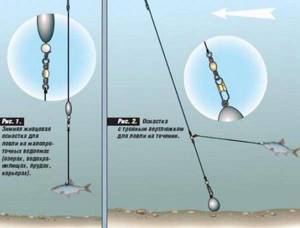
For fishing in snags and reeds
The equipment of a pike rig in winter for fishing in snags requires a more durable one, allowing you to drag it “like a fool.” You can include an additional tee in the installation diagram by passing a leash through its ring. You will get an additional sliding hook. In this case, the lower double is inserted under the gills into the mouth, and the upper tee clings to the back. It is important to quickly hook the pike so that the predator does not have time to unwind the tackle and lead it into snags or reeds. Accordingly, the free flow of the fishing line is limited to 1-1.5 meters, after winding which you need to immediately hook it. Conventional rigs with a long stroke are recommended to be placed 5-7 meters from snags, but blind rigs can be placed in the wilds or narrow reed windows. The percentage of catches in the case of passive biting in such conditions is higher, but the probability of catching a toothy one is higher.
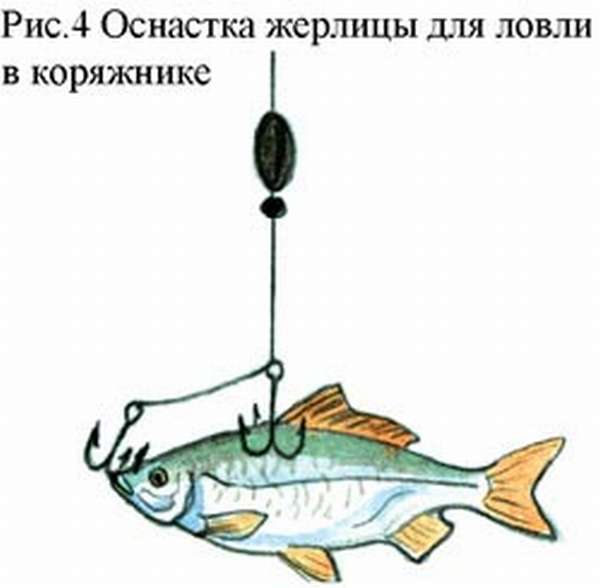
Types of hooks for catching pike
When choosing a hook for fishing a toothy predator, you should focus on the type of gear and bait used. When selecting a suitable model, you also need to take into account the activity of the fish at the time of fishing and the nature of its feeding.
Offset (“single”)
“Offset” is used in combination with soft silicone baits. A twister or vibrotail mounted on it is less susceptible to snags on snags and other underwater objects. It is used in equipment:
- classic “jig”;
- "Carolina"
- "jig-rig";
- "Texan"
- with a retractable leash.
The artificial bait is placed so that the sting fits tightly to its soft body. When a fish bites, it squeezes the silicone and the tip opens, providing a reliable hook.

The stepped bend of the “offset” near the ring reliably fixes the head part of the bait.
When fishing with unloaded “rubber” in places with a depth of up to 1 m, you need to choose an “offset” made of thin, elastic wire. Such models are light in weight, which facilitates the slow descent of the bait during step-by-step retrieval. The slow dive of the vibrotail to the bottom provokes even a well-fed predator to attack.
On a note! When fishing at a depth of 1 to 2 m, loaded “offsetters” are used. The role of the load is performed by lead fused to the back side. Such models reach the desired fishing horizon faster, which increases the pace of fishing.
In the “Carolina” and “Texas” rigs, the “offset machine” is equipped with a “bullet” type load, which passes well through underwater obstacles. In the classic “jig” version, the non-clinging “single” is equipped with a “Cheburashka” weight.
You need to tie the offset machine with a simple clinch knot. In “jig-rig” and “jigging” rigs, a connection through a fishing carabiner is used.
Double (double hook)
“Double” is considered a universal option. It is used when fishing with live bait and artificial baits. It is included in the equipment:
- Zherlits;
- "suppliers";
- "circles".
In spinning fishing, foam fish, twisters and vibrotails are equipped with “doubles”. They are attached to the weights through winding rings. Collapsible Cheburashka weights allow you to fish by attaching them directly.
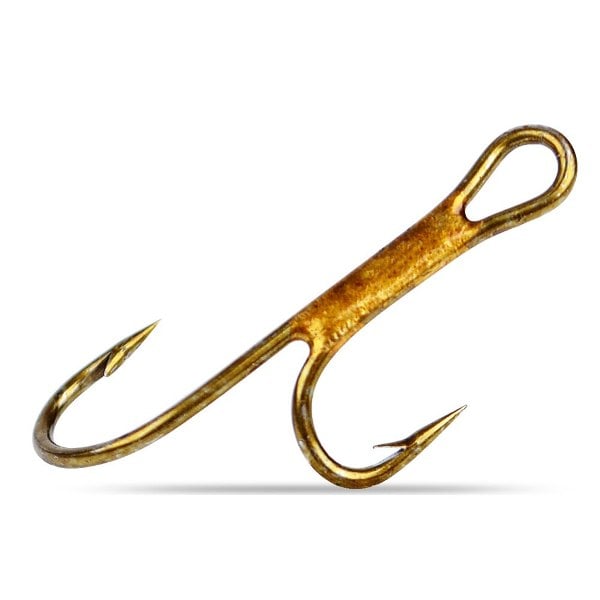
“Doubles” with different sizes of individual hooks are used in live bait rigs.
When fishing on rivers with a rocky bottom, wobblers are equipped with such models. To avoid snagging, the tips should be directed upward.
Spinning fishing with a double is carried out in relatively clean places, since it is more susceptible to snags than a single. However, it holds fish better and minimizes the number of escapes.
The “double” is attached to spinning baits through winding rings. When fishing with girders and circles, a “Rapal” knot is used, which allows the live bait to move freely.
Tee
The triple hook cuts through the bony mouth well and reliably holds the predator while playing. Such models are used to equip “mugs” and girders, and also equip various spinning lures:
- oscillating and rotating spoons;
- wobblers;
- jerkbaits;
- tail spinners;
- topwaters.
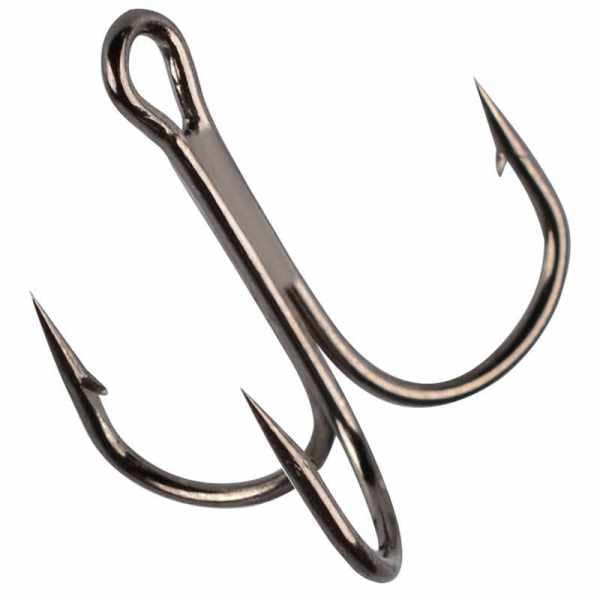
When catching trophy fish with large vibrotails, they use a homemade installation consisting of two “tees” installed in the head and middle parts of the silicone bait. This method of arranging hooks provides a more reliable hooking.
“Tees” cannot be used on snagged areas of reservoirs, since the risk of snagging increases significantly. These models are not suitable for catch-and-release fishing, as they severely injure the fish. You can get them out of the toothy mouth only with the help of special devices.
In live bait rigs, triples are best used in “wild” reservoirs, where there is no strong fishing pressure, and pike take the bait less carefully. They are attached to fishing line and baits in the same ways as “doubles”.
Non-snacking hooks
Pike likes to stand in places overgrown with aquatic vegetation and snags. In such conditions, unhooked hooks are used to catch it.
Wire elements installed at the ring and protecting the sting from snagging help ensure the hook can pass freely through thickets and snags. When biting, the structure folds and the tip is free. “Non-hooking” devices are equipped with:
- oscillating spoons;
- silicone baits;
- topwaters;
- spinnerbaits.
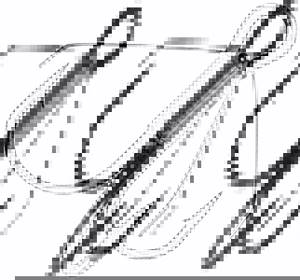
Prices for “non-hooking” baits are slightly higher than for classic models, but this is more than justified by the preservation of expensive spinning lures.
Wire fenders can be installed on all types of hooks. Such designs have disadvantages, the main of which is low grip, leading to a large number of unrealized bites.
Finnish
The Finnish fish hook is used in live bait rigs. You can make it yourself from a nail or steel wire. This model is used only in combination with a hard metal leash. Live bait is attached in 3 stages:
- A metal leash is carefully passed through the gill cover and brought out through the mouth opening of the baitfish;
- A Finnish leash is attached to the end of the leash brought out through the fish’s mouth;
- A fishing line is tied to the other end (through a carabiner).
After the attack, the pike turns its prey around and swallows it head first. Due to the fact that the hook is located along the body of the fish, the predator does not notice it and swallows it very deeply. A derailment can only occur if the cutting is untimely. After biting, the angler needs to wait at least 5 minutes.

Today, a cobra hook cannot be bought in fishing stores, so craftsmen make it themselves.
Live bait rigs also use a “cobra”, which has an original shape. This model is effective when the fish is active and boldly takes the bait offered to it.
